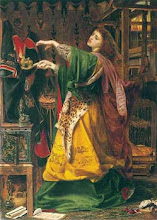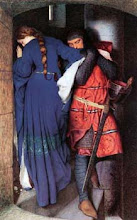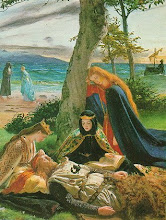Selyf (Solomon) 'Serpent of Battle' (Sarffgadau) son of Cynan Garwyn, King of Powys died in about 613 at the battle of the City of the Legions (Chester) fighting against King Æthelfrith of Bernicia and Deira (Northumbria). His death is recorded in the Annals Cambriae and the Irish annals. According to Welsh poetry attributed to Taliesin, his father Cynan Garwyn had been a major over-king in Wales in the previous generation. The Battle of Chester took on a life of its own in Welsh legend and was elaborated in both Geoffrey of Monmouth and the Welsh triads.
The dragon or serpent has been associated with Welsh kings since the earliest post-Roman reports of Britain. Gildas refers to king Maglocunus (Mailcun/Maelgwyn of Gwynedd) as the head serpent of the isles, ie. pendragon (literally pen = head, dragon) in c545. Selyf Sarffgadau ('Serpent of Battle' / Battle Serpent) is one of the best recorded of the dragon kings. Cadwallon of Gwynedd, Selyf's reputed nephew, best known for killing Edwin of Deira, was also referred to as dragon of the isles in a fragmentary death song. Of course, in Welsh legend the ultimate Pendragon dynasty is that of Arthur son of Uther Pendragon.
In the Welsh Triads, Selyf is listed as one of the three "Battle-Leaders of the Isle of Britain". In the Black Book of Carmarthen's triad 43 he is the owner of one the three great pack horses, which may be an allusion to his ability to move a large army over great distances. However, this horse is credited to his father Cynan Garwyn in triad 39. In Taliesin's poetry, Cynan Garwyn is credited with very wide ranging victories throughout what is today Wales. The name of Selyf's bard, Arofan, is also remembered in the triads. Selyf ap Cynan is also mentioned as a companion of Owen ap Urien in the Arthurian tale the Dream of Rhonabwy. Bartrum notes that Selyf and Owen would have been contemporaries — both opponents of Æthelfrith– but not with the Arthurian setting or Arthur himself. In Welsh poetry, Arthur is usually outside of time, or almost in Welsh version of Valhalla where all the greatest heroes of all eras are part of his retinue. The poet Cynddelw also refers to Selyf in his poem Breineu Powys (Priviledges of Powys) in the line "Kananwon Selyf seirff cadeu" (Descendants of Selyf, serpents of battles).
According to the welsh pedigrees and hagiography, Selyf had four sons, none of whom succeeded him. The Life of St. Beuno claims that it was Beuno's curse that prevented their succession. It seems just as likely that the utter destruction of Powys by Æthelfrith blocked his lineage from the throne. Under consistent Northumbrian pressure, Powys seems to have been ruled by multiple small dynasties in the early seventh century. Some of these dynasties appear to have allied themselves with Mercia against Northumbria. Most of the territory of Powys was probably annexed by Mercia to their immediate east. It seems likely that Selyf was the last Powysian king to rule over a large midlands kingdom that dominated the whole region, east and west. It is possible that the Brochwel/Brocmail who Bede reports abandoned the monks of Bangor-Is-Coed to Æthelfrith's forces was one of Selyf's kinsmen; Brochwel is a name common in his dynasty.
When a single dynasty emerges again in Powys it does claim descent from Selyf's kindred. Most claims are to a brother Eiludd but other lineages claim descent from a Beli ap Selyf, Eiludd ap Selyf, or Beli ap Mael Myngan ap Selyf. It is possible that none of them were truly related to Selyf but felt the need to claim a link to his lineage. In the Bonedd y Sant (Pedigrees of the Saints), Selyf ap Cynan is claimed to be the father of St. Dona.
Selyf's chief defended cities at the time are believed to have been Chester and the hill fort at the Wrekin above Wroxeter, probable namesake of the Wreconsaete of the tribal hinge. Viroconium Cornoviorum (Wroxeter) was the civitas capital for the Cornovii, Powys likely tribal orgins, while Chester had been a legionary base during the Roman occupation.
Selyf's dominance in Wales is suggested by the role his main monastery, Bangor-Is-Coed, played in negotiations with Augustine of Canterbury. After the initial meeting at Augustine's Oak, the Annals Cambriae records a Synod of City of the Legions (Chester) in 601 that may be the conference Bede refers to in between the first and second meeting with Augustine. The fact that the synod was held in Selyf's primary city suggests that he was the dominant king who did not want to associate with the Canterbury mission. The slaughter of the monks of Bangor-Is-Coed, under Powy's protection, was said by Bede to have been a fulfillment of Augustine's prophecy.
The dragon or serpent has been associated with Welsh kings since the earliest post-Roman reports of Britain. Gildas refers to king Maglocunus (Mailcun/Maelgwyn of Gwynedd) as the head serpent of the isles, ie. pendragon (literally pen = head, dragon) in c545. Selyf Sarffgadau ('Serpent of Battle' / Battle Serpent) is one of the best recorded of the dragon kings. Cadwallon of Gwynedd, Selyf's reputed nephew, best known for killing Edwin of Deira, was also referred to as dragon of the isles in a fragmentary death song. Of course, in Welsh legend the ultimate Pendragon dynasty is that of Arthur son of Uther Pendragon.
In the Welsh Triads, Selyf is listed as one of the three "Battle-Leaders of the Isle of Britain". In the Black Book of Carmarthen's triad 43 he is the owner of one the three great pack horses, which may be an allusion to his ability to move a large army over great distances. However, this horse is credited to his father Cynan Garwyn in triad 39. In Taliesin's poetry, Cynan Garwyn is credited with very wide ranging victories throughout what is today Wales. The name of Selyf's bard, Arofan, is also remembered in the triads. Selyf ap Cynan is also mentioned as a companion of Owen ap Urien in the Arthurian tale the Dream of Rhonabwy. Bartrum notes that Selyf and Owen would have been contemporaries — both opponents of Æthelfrith– but not with the Arthurian setting or Arthur himself. In Welsh poetry, Arthur is usually outside of time, or almost in Welsh version of Valhalla where all the greatest heroes of all eras are part of his retinue. The poet Cynddelw also refers to Selyf in his poem Breineu Powys (Priviledges of Powys) in the line "Kananwon Selyf seirff cadeu" (Descendants of Selyf, serpents of battles).
According to the welsh pedigrees and hagiography, Selyf had four sons, none of whom succeeded him. The Life of St. Beuno claims that it was Beuno's curse that prevented their succession. It seems just as likely that the utter destruction of Powys by Æthelfrith blocked his lineage from the throne. Under consistent Northumbrian pressure, Powys seems to have been ruled by multiple small dynasties in the early seventh century. Some of these dynasties appear to have allied themselves with Mercia against Northumbria. Most of the territory of Powys was probably annexed by Mercia to their immediate east. It seems likely that Selyf was the last Powysian king to rule over a large midlands kingdom that dominated the whole region, east and west. It is possible that the Brochwel/Brocmail who Bede reports abandoned the monks of Bangor-Is-Coed to Æthelfrith's forces was one of Selyf's kinsmen; Brochwel is a name common in his dynasty.
When a single dynasty emerges again in Powys it does claim descent from Selyf's kindred. Most claims are to a brother Eiludd but other lineages claim descent from a Beli ap Selyf, Eiludd ap Selyf, or Beli ap Mael Myngan ap Selyf. It is possible that none of them were truly related to Selyf but felt the need to claim a link to his lineage. In the Bonedd y Sant (Pedigrees of the Saints), Selyf ap Cynan is claimed to be the father of St. Dona.
Selyf's chief defended cities at the time are believed to have been Chester and the hill fort at the Wrekin above Wroxeter, probable namesake of the Wreconsaete of the tribal hinge. Viroconium Cornoviorum (Wroxeter) was the civitas capital for the Cornovii, Powys likely tribal orgins, while Chester had been a legionary base during the Roman occupation.
Selyf's dominance in Wales is suggested by the role his main monastery, Bangor-Is-Coed, played in negotiations with Augustine of Canterbury. After the initial meeting at Augustine's Oak, the Annals Cambriae records a Synod of City of the Legions (Chester) in 601 that may be the conference Bede refers to in between the first and second meeting with Augustine. The fact that the synod was held in Selyf's primary city suggests that he was the dominant king who did not want to associate with the Canterbury mission. The slaughter of the monks of Bangor-Is-Coed, under Powy's protection, was said by Bede to have been a fulfillment of Augustine's prophecy.



































3 comments:
I Love your work, I'll say again, Thank-you for Sharing
wayne xx
Thank you my dearest friend,
Have a great time!!
Peace and Love from Camelot...
Leide
xxx
Post a Comment